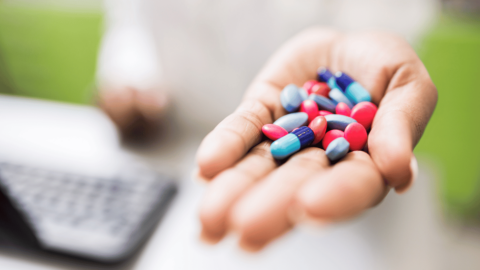Imagine this: You just had surgery, and your doctor hands you a prescription for oxycodone. You’ve heard horror stories about opioid addiction, and a nagging thought creeps into your mind—“What if I get addicted?”
It’s a valid concern. The opioid crisis shows how quickly dependence on prescription painkillers can spiral into addiction, possibly leading to devastating consequences such as job loss, damaged relationships, and financial trouble.
But does that mean anyone who takes opioids for pain relief is at risk? And if you take them exactly as prescribed, are you safe?
The answer is more complicated than a simple yes or no. Let’s break down the difference between dependence and addiction, what puts some people at higher risk, and how to use opioids safely.
Knowing the Difference: Dependence vs. Addiction
Many people assume that dependence = addiction, but they’re actually not the same thing.
- Dependence is when your body adjusts to a medication and needs it to feel normal. If you suddenly stop taking it, you’ll experience withdrawal symptoms like sweating, nausea, or body aches. Dependence can happen even when taking opioids exactly as prescribed.
- Addiction is when drug use becomes compulsive and uncontrollable—you take it not just for pain, but because you crave it. People struggling with addiction continue using opioids despite negative consequences, like job loss, damaged relationships, or financial trouble.
Key takeaway: You can become physically dependent on opioids without being addicted, but dependence can increase the risk of addiction over time.
Who Is Most at Risk for Opioid Addiction?
Not everyone who takes painkillers becomes addicted, but certain factors make some people more vulnerable.
Higher-Risk Groups
- People with a history of addiction (to alcohol, nicotine, or other drugs)
- Those with mental health conditions (depression, anxiety, PTSD)
- Patients prescribed opioids for long-term use (chronic pain)
- People with a family history of substance use disorder
- Those who take higher doses or use opioids recreationally
Example: Two patients receive a 10-day oxycodone prescription after surgery. One takes it exactly as directed and stops once the pain is manageable. The other starts taking extra doses for stress relief and continues seeking refills after the pain is gone. The second patient is at far greater risk of addiction.
How to Take Opioids Safely and Reduce Risk
If you need prescription painkillers, there are ways to reduce your risk of dependence and addiction.
1. Take the Lowest Effective Dose
- Use the smallest dose possible for the shortest duration.
- If your pain is mild, try non-opioid pain relievers first (ibuprofen, acetaminophen).
2. Follow Your Doctor’s Instructions Exactly
- Take your medication only as prescribed—never increase the dose without consulting your doctor.
- Avoid crushing, breaking, or chewing extended-release pills, as this can cause dangerous rapid absorption.
3. Watch for Early Warning Signs of Misuse
Ask yourself:
- Am I taking the medication for the pain, or because I like how it makes me feel?
- Do I feel anxious or irritable when I don’t take it?
- Am I taking more than prescribed or running out of medication early?
If you answer yes to these questions, it’s time to talk to your doctor about safer alternatives.
4. Dispose of Leftover Medications Properly
- If you have extra pills, don’t save them “just in case.”
- Many pharmacies and police stations offer medication take-back programs.
Example: A patient recovering from a car accident is prescribed hydrocodone. After two weeks, their pain is manageable with ibuprofen, but they still have extra pills. Instead of keeping them, they drop them off at a pharmacy take-back site to eliminate the temptation of misuse.
What If You’re Already Dependent on Opioids?
If you find yourself needing opioids just to feel normal, you may have developed dependence or addiction—and you’re not alone. Millions of people have safely transitioned off opioids with the proper support.
There are two main options:
- Gradual tapering – Slowly reducing your opioid dose under medical supervision can help minimize withdrawal symptoms.
- Medication-assisted treatment (MAT) – If tapering isn’t enough, medications like Suboxone (buprenorphine-naloxone) can help manage cravings and withdrawal safely.
How QuickMD Can Help with Opioid Use Disorder
If you’re worried about opioid dependence or struggling with cravings, QuickMD offers fast, discreet, and affordable treatment from the comfort of home.
QuickMD’s Online Opioid Addiction Treatment Includes:
- Telemedicine Suboxone treatment – Speak with a certified doctor and get a same-day prescription sent to your local pharmacy.
- Online counseling services – Get expert support for addiction, stress, and mental health, starting at just $45 for 30 minutes.
- Flexible scheduling – Appointments are available 7 days a week, including evenings and weekends.
- No long wait times or clinic visits – Get help privately and conveniently from home.
Final Thoughts
Prescription opioids can be safe when used correctly, but they also carry risks. While taking them as prescribed lowers the risk of addiction, it doesn’t eliminate it entirely. Recognizing the signs of dependence early and using opioids responsibly can help you stay in control of your health.
If you or a loved one is struggling with opioid use, treatment is available—and recovery is possible.
Need help? Talk to a QuickMD doctor today.




